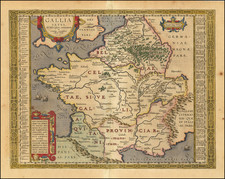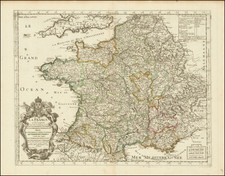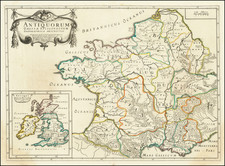An Early System For Determining Postal Rates? -- Rare Scale of Miles
Fine old color example of this magnificent scale of miles, created by Sr. Faurot, a Royal Engineer to the King of France, and published by Mortier in Amsterdam.
Distance table covers the distances between French, German, Belgium and Dutch towns. Each place name with a short comment. The large decorative title cartouche with includes a short explanation how to use the table
This finely detailed work allowed for the display of the distances between dozens of cities on a single sheet, a system that was still in use for road maps well into the second half of the 20th Century.
The possibility that the chart was intended to help calculate postal rates is discussed at length in an article by Nicholas Verdier:
L’échelle géographique (…) des principales villes… est une matrice triangulaire des distances qui peut avoir été élaborée à partir des cartes des routes de Poste ou qui peut l’avoir été en s’appuyant sur la Carte générale des étapes de France dont on connaît quatre exemplaires (1710, 1746, 1755, 1795). Il s’agit d’une carte liée au Génie militaire, et dont l’objet est de dépeindre les voies de communication à employer pour se rendre d’un point à un autre du territoire. Cette dernière ressemble dans son principe aux cartes des routes de Poste, même si le niveau de simplification est beaucoup plus élevé et que par ailleurs les lieux de forte nodalité postale, comme Paris, comptent ici moins de liens (15). Partant d’un ensemble de routes, la matrice offre un ensemble de possibilités de liaison entre chaque lieu. Le système de relations est ici avéré même si dans ce type de représentation l’idée de carrefour disparaît. Ce modèle est également employé lors de la mise en place du nouveau tarif de la Poste aux Lettres, en 1791 (doc. 5). Celui-ci permet de calculer le tarif d’acheminement de courrier de centre théorique de département à centre théorique de département.
Même si dans ce dernier cas les distances sont toutes théoriques, puisqu’il s’agit à peu près des centroïdes des départements, ce qui importe ici est d’abord une pensée de mise en relation de l’ensemble des points entre eux par des lignes, qu’elles soient des routes militaires ou des distances théoriques.
Translation:
The geographical scale (…) of the main towns… (doc. 4) is a triangular matrix of distances which may have been drawn up from maps of Post Roads or which may have been drawn up based on the General Map stages in France, four of which are known (1710, 1746, 1755, 1795). This is a map related to Military Engineers, and the purpose of which is to depict the communication routes to be used to get from one point of the territory to another. The latter resembles in principle the maps of postal routes, even if the level of simplification is much higher and that, moreover, places of strong postal nodality, such as Paris, have fewer links here (15). Starting from a set of routes, the matrix offers a set of connection possibilities between every place. The system of relations is here proven even if in this type of representation, the idea of a crossroads disappears. This This model was also used when the new letter post rate was introduced in 1791. This allows you to calculate the mail delivery rate from the theoretical center of the department to the theoretical center of the department.
Even if in this last case the distances are all theoretical, since it is about the centroids of the departments, what matters here is first of all a thought of putting all the points in relation to each other by means of lines, whether military routes or theoretical distances.
Rarity
The table is surprisingly rare.
https://www.cairn.info/revue-flux1-2007-2-page-7.htm
Pierre, or Pieter, Mortier (1661-1711) was a Dutch engraver, son of a French refugee. He was born in Leiden. In 1690 he was granted a privilege to publish French maps in Dutch lands. In 1693 he released the first and accompanying volume of the Neptune Francois. The third followed in 1700. His son, Cornelis (1699-1783), would partner with Johannes Covens I, creating one of the most important map publishing companies of the eighteenth century.










![Comparative Size of Lakes and Islands [Great Lakes, Cuba, Formosa, Ireland, Sicily, Cyprus, Vancouver, Sandwich Islands, Puerto Rico, Corsica, Sardinia, Balearics, Malta, etc]](https://storage.googleapis.com/raremaps/img/small/100135.jpg)
![(Franco-Prussian War) Fameux Probleme Algebrique & Politique [Famous Algebraic & Political Problem]](https://storage.googleapis.com/raremaps/img/small/86125.jpg)


![[ Academia Land ] Kaart van het Stichtsche Academie-Land [ Stichtsche Academy Land ]](https://storage.googleapis.com/raremaps/img/small/74913.jpg)